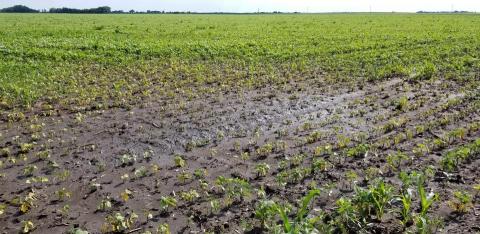Stalk Quality Concerns Widespread in Areas of Nebraska
September 27, 2019
The effects of late planting and stressful growing conditions throughout much of the season are showing up now in poor stalk quality in corn. Growers are encouraged to scout fields and harvest those most at risk of lodging first. Here's why and what to look for.
How Does Cool Cloudy Weather Affect Corn During Grain Fill?
September 20, 2019
Cool or cloudy weather in late August during the grain-fill period can enhance or reduce yield, often depending on whether there's an early frost.
The Big Unknown in Corn Yield Forecasts
June 27, 2019
Each year surveys and models are used to forecast final corn yields as the crop progresses through the season. Cropping Systems Specialist Roger Elmore looks at two forecast systems and examines 10 years of USDA National Agricultural Statistics Data to see how forecasts deviated from actual yields.
Looking Back at Corn Planting Progress and Fieldwork Day Records: 1996 -2019
June 21, 2019
How do this year's corn planting delays compare with other years here and those in Illinois. After observing fields from Nebraska to Illinois on a recent trip, agronomist Roger Elmore digs into agricultural statistics dating back to 1996 to see just how this planting season and fieldwork days compare with previous ones.
Considerations after Crusted Soybean
June 14, 2019
Soil crusting is challenging soybean emergence, but is it enough to warrant replanting? Here are early steps to remediate crusting problems and factors to consider when considering replanting.
Study Highlights Motivations and Impact of Participating in an On-Farm Research Network
May 31, 2019
Forty Nebraska growers participating in the On-Farm Research Network recently shared why they conduct on-farm research and what it's meant to be part of a group of researchers. The results, published in the Agronomy Journal, illustrate a range of benefits, including cost savings and economic gains.

Corn Establishment and Growth in Saturated Soils: A Brief Review of New Research
May 31, 2019
How long can seedling corn survive under flooded conditions? A review of current scientific literature offers new understandings of when and how plant injury occurs and what factors affect it.
Response of Germinating and Early Season Soybeans to Flooding
May 30, 2019
Injury to germinating and seedling soybean from flooding depends on several factors, including soybean growth stage, flood duration, and air and soil temperature and varies the varieties. Pythium and Phytophthora are two diseases to scout for after flooding.







